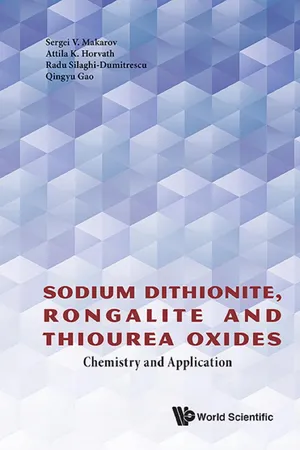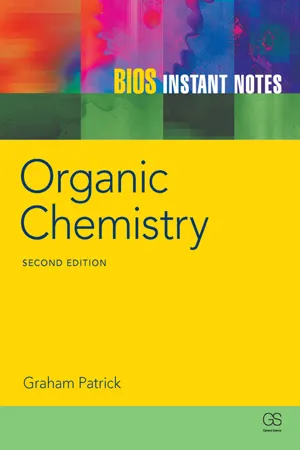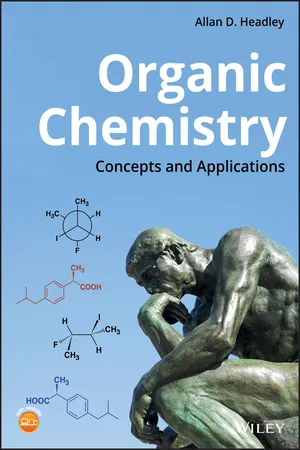Chemistry
Reactions of Halides
Reactions of halides refer to the chemical reactions involving halogen-containing compounds, such as chlorides, bromides, and iodides. These reactions often involve substitution, elimination, or addition reactions, where the halide group is replaced or modified. Common reactions of halides include nucleophilic substitution, SN1 and SN2 reactions, and elimination reactions, which are important in organic chemistry and synthesis.
Written by Perlego with AI-assistance
Related key terms
Related key terms
1 of 4
Related key terms
1 of 3
3 Key excerpts on "Reactions of Halides"
- eBook - ePub
Sodium Dithionite, Rongalite And Thiourea Oxides: Chemistry And Application
Chemistry and Application
- Sergei V Makarov, Attila K Horv??th;Radu Silaghi-Dumitrescu;Qingyu Gao;(Authors)
- 2016(Publication Date)
- WSPC (EUROPE)(Publisher)
Chapter 6
Organic Reactions
6.1Synthesis of Organofluorine Compounds
Sulfur-containing reductants are used in organofluorine chemistry as sulfina-todehalogenation agents. Sulfinatodehalogenation is one of the most important methods of introducing fluorine atoms in organic molecules [283 –285 ]. It is a simple and efficient reaction for synthesizing of polyfluoroalkanesulfinates and sulfonates. The reaction can also be applied for the polyfluoroalkylation of organic compounds [284 ]. Sulfinatodehalogenation can directly convert a perfluoroalkyl halide into the corresponding perfluoroalkanesulfinate, without using harsh reaction conditions. Among numerous fluoroalkyl halides, iodides are more reactive than bromides, but chlorides are inert in common conditions. Substrates with long fluoroalkyl chains are usually more reactive than those with short ones [283 ]. The sulfinatodehalogenation reaction can easily be scaled up to an industrial level. Perfluoroalkanesulfinates can also be transformed into perfluoroalkanesulfonic acids and their derivatives, which are excellent surfactants and can as well be used to prepare ion exchange membranes [283 ]. Low price of reagents, mild reaction conditions, good yields and applicability to wide range of substrates all make sulfinatodehalogenation very popular.The sulfinatodehalogenation reaction was discovered by Huang and his coworkers, in 1981, when the sulfinate salt −O2 SCF2 CF2 OCF2 CF2 (sodium or potassium salt) was formed if the difluoroiodomethyl-containing compound ICF2 CF2 OCF2 CF2 SO2 F was treated with sodium sulfite in aqueous 1,4-dioxane (that is, the CFJ group was transformed into a CF2 SO2 Na(K) group) [286 ,287 ]. Interestingly, this reaction does not proceed in aqueous solution. It was found that the presence of a small amount of dioxane hydroperoxide in the dioxane used was responsible for the reaction, i.e. sulfite should be oxidized to sulfite anion radical [284 ]. A single electron transfer (SET) process was proposed to explain the course of the process [284 - eBook - ePub
- Graham Patrick(Author)
- 2004(Publication Date)
- Taylor & Francis(Publisher)
SECTION L — ALKYL HALIDESL1 Preparation and physical properties of alkyl halides
Key Notes
Preparation Alkenes are converted to alkyl halides by reaction with hydrogen halides. Treatment with halogens results in dihaloalkanes. Tertiary alcohols can be converted to alkyl halides on treatment with hydrogen halides, whereas primary and secondary alcohols are best converted by using thionyl chloride or phosphorus tribromide. Structure Alkyl halides consist of an alkyl group linked to a halogen. The carbon linked to the halogen is sp 3 hybridized and tetrahedral. The carbon–halogen bond length increases and the bond strength decreases as the halogen increases in size. Bonding The C–halogen bond (C–X) is a polar σ bond where the halogen is slightly negative and the carbon is slightly positive. Intermolecular bonding is by weak van der Waals interactions. Properties Alkyl halides have a dipole moment. They are poorly soluble in water, but dissolve in organic solvents. They react as electrophiles at the carbon center. Reactions Alkyl halides undergo nucleophilic substitution reactions and elimination reactions. Spectroscopic analysis The presence of a halogen atom can be shown by IR spectroscopy (C–X stretching absorptions) as well as by mass spectrometry. The latter shows a characteristic pattern of peaks for the molecular ion that matches the number and ratio of naturally occurring isotopes of the halogen. Elemental analysis also demonstrates the presence of halogens. Related topics (A3) sp 3 Hybridization (C3) Intermolecular bonding (C4) Properties and reactions (H3) Electrophilic addition to symmetrical alkenes (M4) Reactions of alcohols (P3) Infra-red spectroscopy (P4) Proton nuclear magnetic resonance spectroscopy (P6) Mass spectrometry Preparation
Alkenes can be treated with hydrogen halides (HCl, HBr, and HI) or halogens (Cl2 and Br2 ) to give alkyl halides and dihaloalkanes respectively (Section H3 ). An extremely useful method of preparing alkyl halides is to treat an alcohol with a hydrogen halide (HX = HCl, HBr, or HI). The reaction works best for tertiary alcohols (Section M4 ). Primary and secondary alcohols can be converted to alkyl halides more effectively by treating them with thionyl chloride (SOCl2 ) or phosphorus tribromide (PBr3 - eBook - ePub
Organic Chemistry
Concepts and Applications
- Allan D. Headley(Author)
- 2019(Publication Date)
- Wiley(Publisher)
Alkanes are fairly inert compounds; some alkanes are used as solvents to provide inert media for different reactions that we will see in later chapters. In addition to combustion, alkanes undergo another type of reaction that is very important to organic chemists, and that is the reaction with halogens, specifically chlorine or bromine in the presence of energy in the form of heat or light. As the name suggests, this reaction involves the reaction of alkanes and bromine or chlorine and is called bromination or chlorination of alkanes, respectively. These reactions are performed in the presence of light or heat and are described as substitution reactions since a hydrogen or more than one hydrogen atoms of an alkane reactant are substituted for a halogen or more than one halogen in the product. Most of the reactions that will be encountered in this chapter involve the substitution of one hydrogen in the alkane for a halogen in the product.The products produced upon the chlorination of alkanes are alkyl halides, most are important industrial raw material for the synthesis of numerous other chemicals. For example, chloromethane was used once as a refrigerant, but discontinued owing to its flammability and toxicity. Today, it is widely used as a chemical intermediate for the production of different compounds, including polymers. Other chloroalkanes are widely used as a solvent in the research labs and in the production of rubber and in the petroleum refining industry. The chlorination of methane is shown in Reaction (14‐5) .(14‐5)To be able to predict the products of these and other similar reactions, a thorough understanding of how the reaction occurs is essential. Before we examine the reaction mechanism for the chlorination of alkanes, let us examine the process of bond reorganization for the reaction shown in Reaction (14‐5) . It should be obvious that this reaction is a substitution reaction in which a Cl─Cl bond has to be broken and the chlorine atoms form two new bonds, a new H─Cl bond and a new C─Cl bond in the CH3
Index pages curate the most relevant extracts from our library of academic textbooks. They’ve been created using an in-house natural language model (NLM), each adding context and meaning to key research topics.
Explore more topic indexes
Explore more topic indexes
1 of 6
Explore more topic indexes
1 of 4


